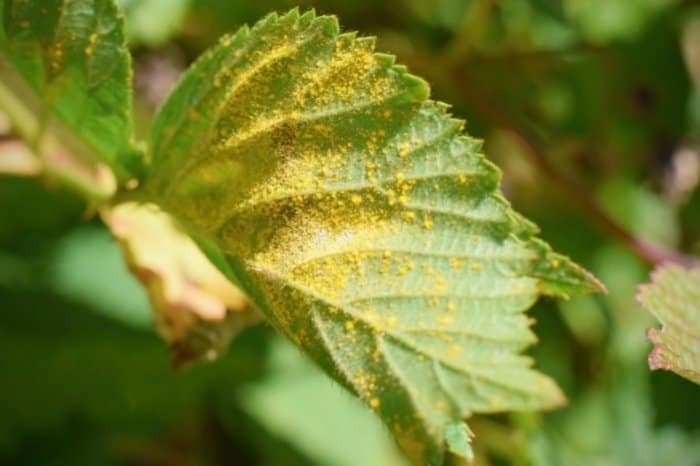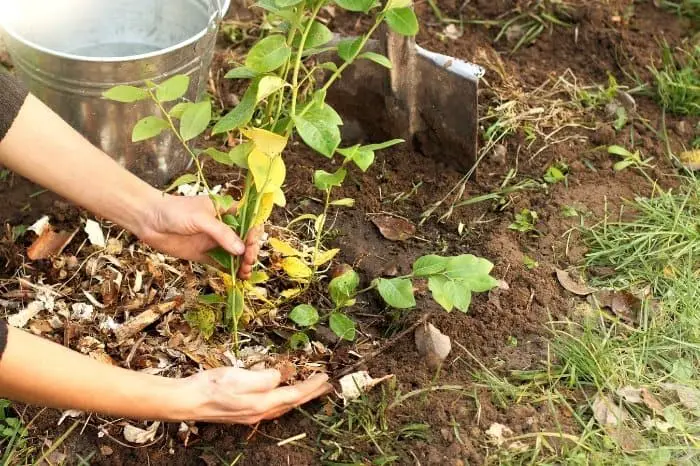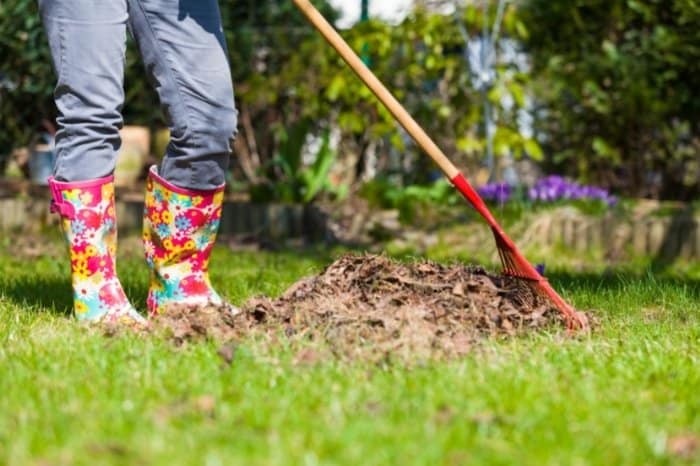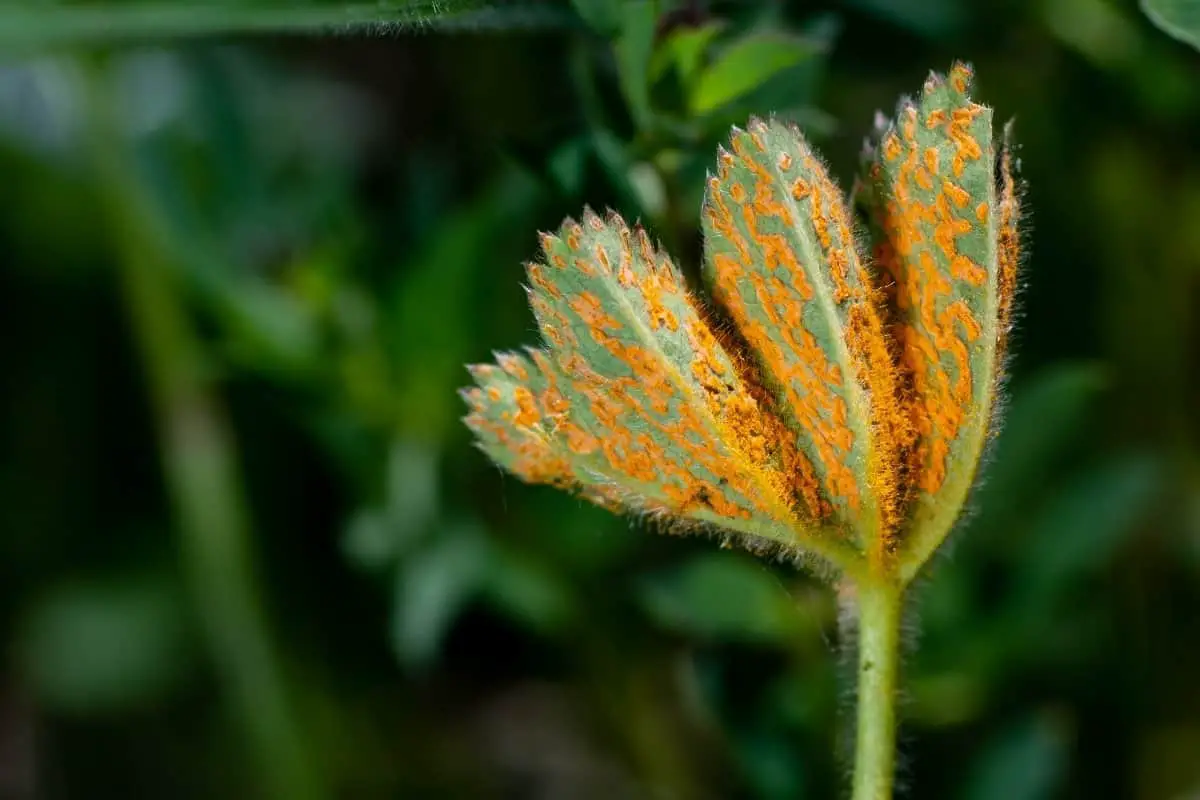Last Updated on October 16, 2023 by Griselda M.
Plant rust is a general term used to describe a large family of fungi that attacks plants. Do you know how to get rid of rust fungus?
Rust on plants are amongst the most common fungal diseases of garden plants. Trees, shrubs, grass, fruits, herbaceous, bedding plants, bulbs, and vegetables can all be affected. When a plant is affected by rust fungi, gardeners do not know how to treat it.
Rust diseases often reduce plant vigor, causing the plant to grow weak. In extreme cases, these infections can even kill plants. Rust treatment is possible but must be started on as early as it’s sighted.
What Is Rust Fungus?
Rust fungus is a group of fungal diseases that affect the top part of a plant. The leaves are the ones that are commonly affected, but rust can also be found on stems, flowers, and fruits.
The rusts spore pustules vary in color, depending on the rust species and the type of spore-producing it. Some rusts come from complex life cycles that involve 2 different host plants and up to 5 spores.
What Causes Rust Spots On Leaves?
Rust spot is a disease caused by a fungal parasite that spreads through the host plant destroying its cells.
This fungal parasite thrives in hot and humid weather and can be tough to eliminate. Rust fungi have numerous spore stages in their life cycles. Some have 5 spore stages, while others have only a few about 3 stages.
The fungi move from one host to the other to complete their life cycles. However, some rust fungi can complete their entire life cycle on a single host.
Symptoms Of Plant Rust
Rust fungi are easy to identify on the plant. Here are some signs to look out for:
- The appearance of pale leaf spots eventually turns into spore-producing structures called pustules.
- The pustules normally appear on the lower leaf surface producing massive numbers of microscopic spores. They can also form on leaf stalks, stems, flowers, and fruit.
- These pustules can be yellow, orange, black, brown, or white. Some have a rusty brown color, giving the rust fungal disease its common name – brown patches.
- In some cases, you will notice dozens of pustules on each leaf. Severely affected leaves could turn yellow and die prematurely.

Rust Fungus Treatment
Once you notice your plants are infected with rust, it’s best to treat them as soon as possible to avoid further damage. Here is how you can treat the rust fungus:
- Eliminate All The Infected Plants. Always keep a close eye on your garden. If you notice any rust infected leaf, stem, or plant, get rid of it immediately. Pull it out and discard it in the trash; do not compost any infected plant parts. The fungus spores survive in the composting process to infect your garden again when used as compost. If you notice your plants have too many leaves or stems infected with rust fungus, discard the entire plant. If you remove these plants early enough, it may stop the infection from spreading to other plants. Remember to discard in the trash, not in the compost.
- Use Neem Oil. Neem oil is highly effective in getting rid of rust fungus. After removing any infected plants or stems, spray the plant weekly with neem to prevent the infection from spreading to the rest of the plant.
How To Prevent Rust Fungus
As a gardener, you know the best way is to prevent instead of treat. We will not sit back and wait for the rust fungus to find its way into our gardens when we can prevent it from happening. How do we do it?
Bonide 811 Copper 4E Fungicide 16oz (473ML)
Do Not Introduce It To Your Garden
When buying plants, be careful you don’t buy any that has signs of rust fungus. Look at the plants closely and ensure there are no signs at all. If you spot any symptoms of this disease, don’t purchase the plant and let the seller know.
Plant Rust-Resistant Varieties Among Your Crops
Plant rust-resistant flowers to ensure rust does not affect your garden. Also, you can plant hybridizers are working hard to develop new varieties of rust-resistant plants.
Water Your Plants Only At The Roots
Rust prefers a moist environment. Your watering technique will need to change to help keep your plants safe. Stop watering from overhead so that the water does not splash onto the foliage.
Rust is also spread through water droplets if you water from overhead with a can or water hose. You can spread the spores from infected leaves to healthy ones through the water splash. Using drip irrigation helps deliver water to the roots, only leaving the foliage dry and healthy.
Use Mulch To Cover Your Soil
Mulch is good to keep the soil moist, so you need to water less often. Mulching also prevents the weeds from growing, keeping your plants healthy.

Space Your Plants Properly
Sometimes, when we run out of space, we can squeeze in plants to create room for more. Overcrowding plants invites disease and insect infestation, and rust fungus is not an exception.
Rust fungus is passed very easily from plant to plant through wind or water in a crowded garden. You can end up with a full garden infected.
Use A Preventive Fungicide To Get Rid Of Rust Fungus
Use a homemade organic or store-bought fungicide to cut off the spread of this fungal disease.
If you have aspirin in the house, you can make your own fungicide by dissolving 2 uncoated aspirin in a quart of water or 8 aspirin in a gallon of water. Once dissolved, spray on your plants in the early spring, including the undersides of the leaves.
You can also use baking soda to make a fungicide. Mix 4 teaspoons of baking soda with 1 ounce of horticultural oil in a gallon of water. Use this mixture in the spring, and be sure to spray the undersides of the leaves plus the entire plant.
Clean Up Your Garden During The Fall Season
During the fall season, remove all dead plant material from the garden so that the spores have no place to overwinter and re-infect your garden in the spring.

Conclusion
It is best to use organic fungicides to get rid of rust fungus because it does not leave your garden with any chemical residues.
It is also important to treat it as early as possible to save your crops when you can!
FAQs
What kills rust on plants?
Rust is caused by a fungus that lives on the leaves of the plant. The fungus sends out small, needle-like structures called haustoria which penetrate the leaf tissue and then secrete enzymes which dissolve the cell wall and kill the plant cells. When the plant dies, the spores from the fungus are released. These can be spread by wind or water to other plants where they will start the cycle again.
To kill rust, I would use a good garden spray (not water based) with a mild soap or detergent in it and let it sit for a few days. This will help loosen the rust and kill any bacteria that may be present.Then I would use a stiff wire brush and steel wool and scrub the area clean. I would then take a bleach solution and scrub that area again. Let dry completely and apply another coat of paint. This may not work for all rust, but it is worth a try.
Can rust fungus kill trees?
It would kill trees, but not all trees.
If you’ve ever visited a park in the summer, you may have noticed a lot of dead or dying trees. Many of these trees are likely victims of a disease called tree canker. This is an extremely contagious fungal disease that kills the trees by causing them to rot from the inside out. Tree cankers are caused by a fungus called Phytophthora ramorum, which is a native to California and Oregon.
Since the introduction of this pathogen in 1999, it has spread to every state in the US and Canada. It is estimated that 20% of all trees in the western US are infected with this fungus. Tree cankers can cause trees to die quickly, but they can also take years to kill trees. Trees affected by this disease are more susceptible to other pests and diseases.Since the introduction of this pathogen in 1999, it has spread to every state in the US and Canada. It is estimated that 20% of all trees in the western US are infected with this fungus. Tree cankers can cause trees to die quickly, but they can also take years to kill trees. Trees affected by this disease are more susceptible to other pests and diseases.Since the introduction of this pathogen in 1999, it has spread to every state in the US and Canada. It is estimated that 20% of all trees in the western US are infected with this fungus. Tree cankers can cause trees to die quickly, but they can also take years to kill trees. Trees affected by this disease are more susceptible to other pests and diseases.
What is the best fungicide for rust?
The best fungicide for rust is a copper-based product. The most commonly used products are: Kocide 3000 (copper hydroxide) Masterguard (copper sulfate) Guthion (copper hydroxide) Kocide 3000 is the most effective, but it is also the most expensive. Masterguard is less effective, but less expensive.
FAQs
What kills rust on plants?
Rust is caused by a fungus that lives on the leaves of the plant. The fungus sends out small, needle-like structures called haustoria which penetrate the leaf tissue and then secrete enzymes which dissolve the cell wall and kill the plant cells. When the plant dies, the spores from the fungus are released. These can be spread by wind or water to other plants where they will start the cycle again.
To kill rust, I would use a good garden spray (not water based) with a mild soap or detergent in it and let it sit for a few days. This will help loosen the rust and kill any bacteria that may be present.Then I would use a stiff wire brush and steel wool and scrub the area clean. I would then take a bleach solution and scrub that area again. Let dry completely and apply another coat of paint. This may not work for all rust, but it is worth a try.
Can rust fungus kill trees?
It would kill trees, but not all trees.
If you’ve ever visited a park in the summer, you may have noticed a lot of dead or dying trees. Many of these trees are likely victims of a disease called tree canker. This is an extremely contagious fungal disease that kills the trees by causing them to rot from the inside out. Tree cankers are caused by a fungus called Phytophthora ramorum, which is a native to California and Oregon.
Since the introduction of this pathogen in 1999, it has spread to every state in the US and Canada. It is estimated that 20% of all trees in the western US are infected with this fungus. Tree cankers can cause trees to die quickly, but they can also take years to kill trees. Trees affected by this disease are more susceptible to other pests and diseases.Since the introduction of this pathogen in 1999, it has spread to every state in the US and Canada. It is estimated that 20% of all trees in the western US are infected with this fungus. Tree cankers can cause trees to die quickly, but they can also take years to kill trees. Trees affected by this disease are more susceptible to other pests and diseases.Since the introduction of this pathogen in 1999, it has spread to every state in the US and Canada. It is estimated that 20% of all trees in the western US are infected with this fungus. Tree cankers can cause trees to die quickly, but they can also take years to kill trees. Trees affected by this disease are more susceptible to other pests and diseases.
What is the best fungicide for rust?
The best fungicide for rust is a copper-based product. The most commonly used products are: Kocide 3000 (copper hydroxide) Masterguard (copper sulfate) Guthion (copper hydroxide) Kocide 3000 is the most effective, but it is also the most expensive. Masterguard is less effective, but less expensive.
Caroline is a gardener who loves to get down to the nitty–gritty of gardening. She proudly proclaims herself as a ‘dirt worshipper‘ and can often be found deep in the garden, covered in soil and singing to her plants. As a self–proclaimed ‘plant whisperer‘, Caroline believes that plants need love and attention just like any other living thing, and she loves to give them both. When she‘s not tending to her garden, you can often find her researching the latest gardening trends, or teaching others how to make their gardens thrive



